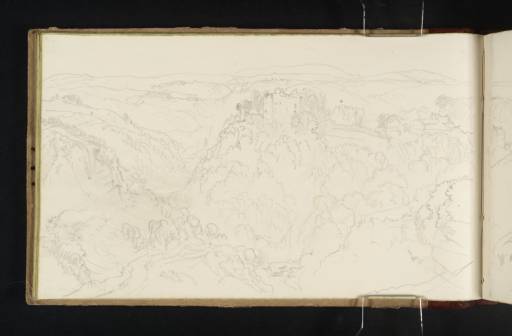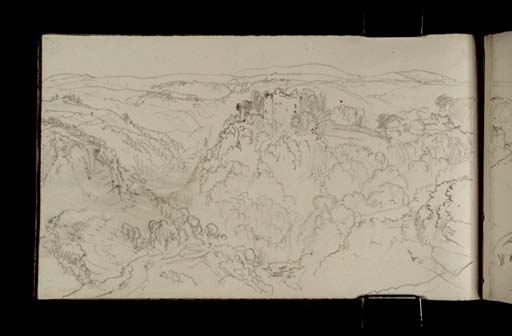Joseph Mallord William Turner Craignethan Castle, Lanarkshire from the North 1834
Image 1 of 2
Joseph Mallord William Turner,
Craignethan Castle, Lanarkshire from the North
1834
Joseph Mallord William Turner 1775–1851
Folio 14 Verso:
Craignethan Castle, Lanarkshire from the North 1834
D26286
Turner Bequest CCLXIX 14a
Turner Bequest CCLXIX 14a
Pencil on off-white wove paper, 113 x 190 mm
Accepted by the nation as part of the Turner Bequest 1856
References
1909
A.J. Finberg, A Complete Inventory of the Drawings of the Turner Bequest, London 1909, vol.II, p.865, CCLXIX 14a, as ‘Ruined castle on hill.’.
1990
Dr David Wallace-Hadrill and Janet Carolan, ‘Turner’s Sketches North of Stirling’, Turner Studies: His Art and Epoch 1775 – 1851, Vol.10 No.1, Summer 1990, p.12.
John Gibson Lockhart, the son-in-law of the late Sir Walter Scott, recorded in his diary on 19 September 1834 that from his family home of Milton Lockhart he ‘walk[ed] w[ith] Mr T[urner]’ to ‘Craignethan Castle’.1 Turner had dined at Milton Lockhart the previous evening,2 and the two men had presumably discussed the illustrations to the planned new editions of Scott’s Prose Works and Waverley Novels as well as to Lockhart’s biography; see Tour of Scotland for Scott’s Prose Works 1834 Tour Introduction. Craignethan Castle, which the public had come to associate with the fictional Tillietudlem Castle, must have been discussed as a possible illustration to Scott’s novel Old Mortality, 1816. 3 Although Scott claimed that ‘I did not think on Craignethan in writing about Tillietudlem’,4 he was happy for the association to continue, writing to the artist James Skene: ‘there can be no objection to adopting it as that which public taste has adopted as coming nearest to the ideal of the place.’5
Turner and Lockhart approached the castle from the north, having followed the road from Crossford and then the River Nethan south towards the castle. Folio 15 verso (D26288) shows that he approached on the opposite side of the river, so he must have found somewhere to cross, probably about half a mile to the south where a modern bridge now stands, before following the river back towards the castle and entering from the west (see folio 16; D26289). The present view from the north is therefore likely to have been his first sketch of the castle. Having arrived at the ruin he walked all the way around it, sketching from every direction, and entering the castle to draw its interior: folios 14 verso–21 (D26286–D26299).6
The present, rather detailed view shows the castle in its setting of the heavily wooded Nethan Gorge. Perched on a high bluff on a turn of the River Nethan, the castle holds a defensive position overlooking the landscape. Turner has delineated the shape of the castle very carefully, including windows or gunloops and the shape of the ruined gables. He paid equal attention to the wooded landscape and the course of the River Nethan. To the right of the main tower house at the south-western corner of the castle is Andrew Hay’s House, a mid seventeenth-century addition to the original sixteenth-century castle (see folio 18; D26293). The sketch continues slightly onto the page opposite folio 15 (D26287). On folio 15 verso is another view of the castle from the north, though made from a little closer-to.
Thomas Ardill
October 2010
Craignethan Castle appears as the engraved title page vignette illustration to volume 10 of Novels and Tales of the Author of the Waverley, 16 volumes, Edinburgh 1821, by William Home Lizars after Alexander Nasmyth.
How to cite
Thomas Ardill, ‘Craignethan Castle, Lanarkshire from the North 1834 by Joseph Mallord William Turner’, catalogue entry, October 2010, in David Blayney Brown (ed.), J.M.W. Turner: Sketchbooks, Drawings and Watercolours, Tate Research Publication, December 2012, https://www


